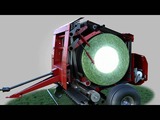
A short video about how alternators work.
- Subject:
- Agriculture Equipment Technician
- Agriculture Studies
- Material Type:
- Open Access Asset
- Author:
- Lesics
- Date Added:
- 06/21/2024

A short video about how alternators work.

How to Load a Grease Gun

I get a lot of questions about which grease is best for a tractor. While I'm not an expert on lubrication, my opinion is, and always has been, that the TYPE of grease is a lot less important than the FREQUENCY of greasing. In 25 years in the ag equipment business I've seen countless incidences of a failure on a piece of equipment that could have been prevented with regular lubrication. I've never once seen a repair that came about because the owner chose the wrong type of grease.
Truth is, for most of us who piddle around with a tractor, do some brush hogging, haul a little dirt around in the bucket and maybe use a grapple to move brush around, a good multi-purpose Lithium grease is all we need. Get one with corrosion inhibitors and oxidation stabilizers. Those additives may drive up the price a little, but they're essential, especially if the equipment is stored outside. That's what I use.
If you'll be using your grease for other applications, then it gets a little more complicated. Let's say you have a skid loader or mini-excavator and you'll be using the grease for both it, and your compact tractor. Then, you may want to move to a Moly grease. Moly greases are more than adequate for light applications like small tractors, and they excel in protection when pins or bushings are under a lot of pressure as they are in an industrial application. They're not a great grease for wheel bearings.
There's been a trend the last few years toward the use of Poly-urea greases. They're definitely a move up from the standard Lithium grease and are used in many sealed bearing applications. Poly-urea greases are thermally stable; high temperature situations don't affect them as they do other greases. They give great oxidation protection and weep oil at a very consistent pace. It is not, however, compatible with other greases. If changing from Lithium grease to Poly-urea, grease more often during the change to work the Poly-urea in to the system.
The absolute top of the line choice for greasing is a synthetic grease. They're EXPENSIVE, but they offer superior heat protection in high speed applications. If you own a round baler or combine with lots of shafts and pulleys moving for hours on end, your owner's manual may tell you to only use synthetic greases. Because of the consistency of synthetics and their ability to dissipate heat, they're the top of the food chain in the grease world.

This video will show you how to use a multimeter to measure voltage, current, resistance, and continuity. This is a beginner's guide aimed at students and electronics hobbyists who need to make basic measurements using an entry-level multimeter.

In this video, Ms. Malam describes how to use an ammeter in Physical Science 8.

Group HES hose and fittings specialist, Stephen Bayliss, guides you through thread identification on Hydraulic Hose fittings.

Removing rounded off nuts and bolts can be difficult and in some cases the nut or bolt could be seized making removal very difficult. If a bolt is seized and is very tight the best option is to reach for the welder, if you have one as the heat generated can help to loosen the bolt making it much easier to remove. Some techniques in this video will work in some situations but not in others. I have covered grip tite sockets, tools with serrated teeth such as mole grips, water pump pliers and Stillsons ;Filing a flat on the bolt, using a hammer and chisel and also welding a nut to the bolt. For difficult to remove bolts the best two methods are the hammer and chisel and welding a nut on the bolt.

A short video on how to use a voltmeter.

An overview of how hydraulic systems work.

Overview of Hydraulic Hoses

How does the hydraulic cylinder work? A hydraulic cylinder has the following parts: piston, rod, seals, wipers, barrel.

When shopping for tractors one of the most important options to consider is which transmission to choose. There are two basic types transmissions which is hydrostat or mechanical with of few variations of each to consider. There are benefits to each option and to know what is the right decision really depends on application and preference. Call or text us at 903-270-0877 and we'd be happy to discuss your options.

This lecture explains the classification of bearings and general awareness about different types of bearings.

An overview of the concept and technology inside the John Deere S690 combine.

Farmers will soon be controlling their tractors with their phones.

LearnOutLoud is a valuable resource for everyone, especially students. It offers a diverse selection of audiobooks, including fiction and educational content, along with video learning, podcasts, courses, and more. While it features some fiction, the site mainly focuses on educational materials and classics, making it less suitable for recent book recommendations or contemporary genre fiction.
Browse using the menu on the left side.
*free courses
*free audiobooks
*free learning documentaries

In this video we cover three free and easy steps to help you incorporate mindfulness at work.

A short video on how manual transmission work.

"Marketplaces is a cutting-edge digital learning experience to equip students with an understanding of how the market works and the confidence to participate in it. Through an engaging, gamified learning experience, students blend economic concepts with investing topics to learn how the government, corporations, and individuals come together to participate in the financial marketplace."

This video explains the baling process of our new generation of high capacity round balers. In addition to explaining the baling process and showing the baler making a bale from a cut a way view it also highlights several key features that are unique to our baler such as the rotary stuffer, Quad Cylinders System (QCS), hydraulically operated drive de-clutcher, simplistic mesh wrap system and hydraulic bale kicker.